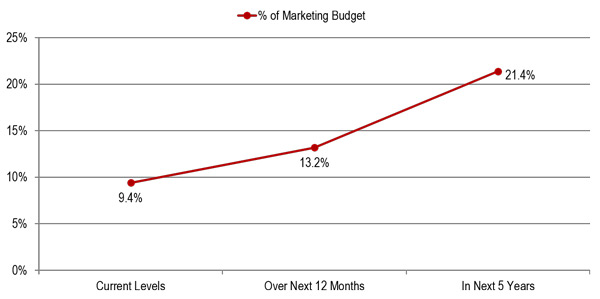New results from The CMO Survey point to this disconnect. Social media spending is currently 9.4% of marketing budgets and is expected to increase 128% to 21.4% in the next five years (see Figure 1). However, the 351 marketing leaders responding to August 2014 survey overwhelmingly report that proof lags spending and only 15% of marketers report their companies can show the impact of social media using quantitative approaches.
What’s the buzz? Companies experienced a 25% percent increase in sales through the Internet in the last year—from 8.9% to 11.3% of sales. There does appear to be a sizable opportunity in reaching customers through the Internet that underlies this spending push. Consistent with this view, digital marketing, more broadly, is expected to increase 10.8% in the next year, while traditional advertising budgets are predicted to decrease 3.6%. In other words, there is a signal in all this buzz.
Figure 1. Social media spending as a percent of marketing budget

Pinning it down: Demonstrating the effect of these spending increases on businesses remains a challenge. Forty-five percent of marketers have not been able to demonstrate this impact at all while 40% have qualitative proof only. Getting that all-important quantitative proof, which only 15% have, is essential to justifying this spending (see Figure 2).
Figure 2. How companies demonstrate the impact of social media spending

Doing so will likely require more spending on measuring marketing ROI. Survey results indicate that companies spend only 2.3% of marketing budgets on measuring marketing ROI. It will also require companies to rethink the way they approach such measurement. Survey results also indicate that only 11.9% of companies surveyed use experiments—a method that allows marketers to know with certainty what, whether, and to what degree social media spending impacts performance.